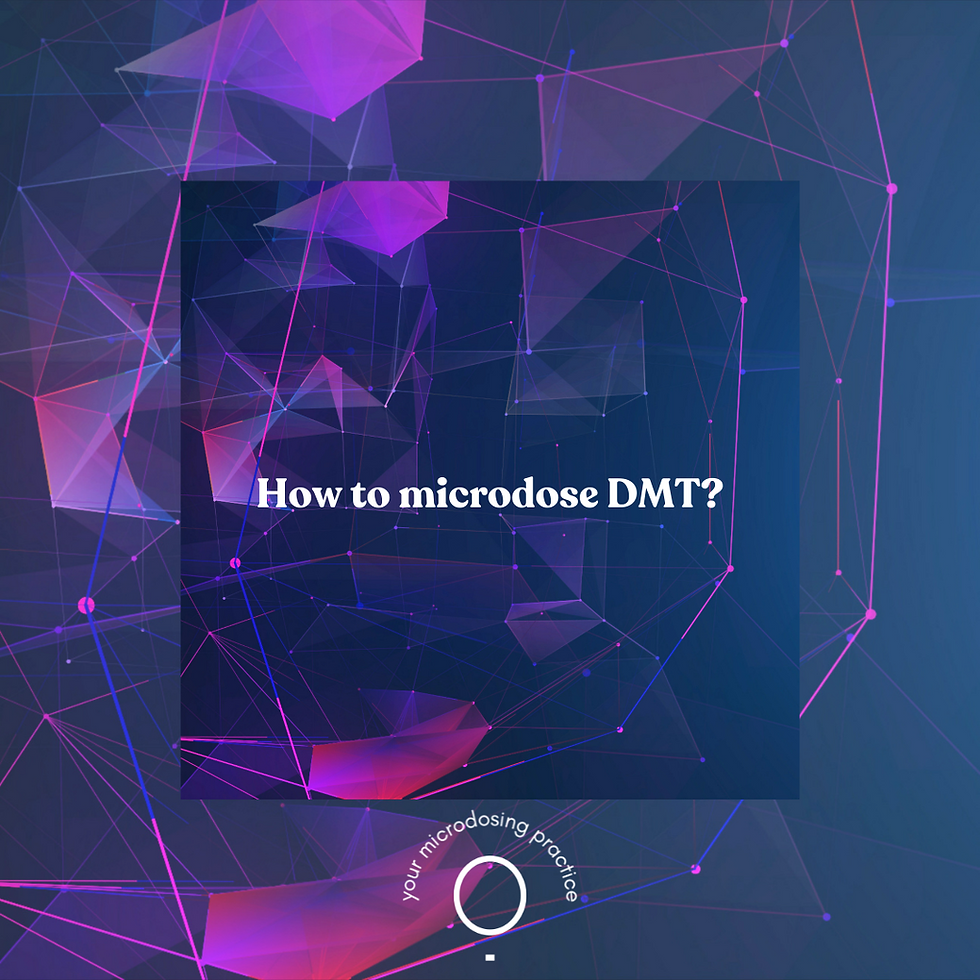The Basics of Microdosing DMT
- Various
- May 14, 2021
- 4 min read
Updated: Jun 10, 2021
While you may be more familiar with the practice of microdosing psilocybin or LSD, there is another powerful psychedelic compound piquing people's curiosity: DMT. Widely associated with a shamanic experience and ayahuasca, N, N-Dimethyltryptamine, or DMT, is slowly creeping into the microdosing world as well.
What is this powerful psychedelic compound? Does it hold the same medicinal value as other psychedelics, even when microdosed?
What is DMT?
N, N-Dimethyltryptamine, or DMT, goes by many names. It has been called the spirit molecule and has long been used by mystics, shamans, and psychonauts to dive into a wholly otherworldly spirit realm.
The DMT molecule is naturally produced by some plants, including those necessary for the preparation of ayahuasca. Many traditional cultures around the world have incorporated these plants into their shamanic and spiritual practices.
However, DMT doesn't just occur in the plant-kingdom. Researchers believe humans also produce our own resource of DMT, known as endogenous DMT.
Inside the human brain lies the pineal gland, an organ with a mystical and superstitious history in human history. This gland has long been associated with our Third Eye and captured the attention of philosophers like Descartes, who believed it contained tiny animal spirits.
Recent research has confirmed that instead of animal spirits, the mammalian pineal gland produces DMT. There are many ideas about why our bodies produce this magical compound, including dreams and near-death experiences. Other experts are less sure, suggesting it may just be a byproduct or waste from the production of other molecules.
But even if it is just a brain byproduct, humans have been exploring the inner universe through phyto-DMT (DMT produced by and extracted from plant sources) for millennia. Preparations of DMT have allowed many to explore different spirit realms, meet otherworldly creatures, and break out of the simulation.
Research into DMT Exploding
With celebrities like Chelsea Handler, Travis Scott, and Joe Rogan now publicly talking about their own experiences with DMT, the conversation around this third-eye molecule is rapidly changing. There are now new studies popping up regularly investigating the effect on humans and whether this compound may have measurable medicinal benefits.
One recent study dosed 13 participants with intravenous DMT as well as a placebo. The study discovered that DMT mimics the mystical experiences commonly reported during near-death experiences.
In the largest surveys ever of DMT experiences, researcher Roland Griffiths and his team analyzed information about a common trip theme that they labelled "the God Experience." After crunching the numbers from 2500 DMT-taking survey respondents, they discovered three quarters reported communicating with another being.
Typical descriptions of this being included intelligent, sacred, conscious, and eternal. A majority also reported that the DMT realm felt more real than their everyday life, and many atheists became spiritual following their trip.
Another interesting study looked at microdoses of DMT for anxiety and mood disorders using a rat model. Instead of a single large dose of DMT used in the studies above, this study wanted to see the effects of ongoing smaller (sub-perceptual) doses.
The authors reported that "chronic, intermittent, low doses of DMT produced an antidepressant-like phenotype" as well as also helping with fear extinction learning, which may suggest help with past trauma. The report concluded, "Psychedelic microdosing may alleviate symptoms of mood and anxiety disorders, though the potential hazards of this practice warrant further investigation."
How to Microdose DMT
Although other psychedelics have a well-established microdosing protocol, microdosing DMT is comparatively less familiar. What's more, unlike magic mushrooms or LSD, DMT is too fast-acting and generally isn't effective orally. Therefore, the only method to microdose is by smoking small amounts or vaping.
Microdosing DMT requires specialized equipment, including a precise scale, a DMT pipe, or a DMT extract vape pen. You may also wish to incorporate DMT freebase (the only option for microdosing this compound) with cannabis or a mixture known as Changa. Changa contains monoamine oxidase inhibitors, which prolong the effects. Combining DMT with additional substances may alter the effects, including leaning into more of a high rather than a microdose.
Currently, the upper limit of a DMT microdose is thought to be 0.1 mg/kg of body weight. A suggested microdose is between 5 to 10 mg. However, many people begin to feel some sensations even with 2 mg. It's best to start with a very low dose as you familiarize yourself with the preparation and effects.
The immediate effects of DMT, at least in microdoses, never lasts for more than 30 minutes. Unlike psilocybin or LSD, there is also no risk of tolerance. Despite this, most resources like the Third Wave suggest sticking with a standard psychedelics protocol like that of James Fadiman, which days off in between doses.
More Research Needed to Explore the Mysteries of DMT
All psychedelics need much more study, but DMT especially. There are already dozens of clinical trials underway exploring its efficacy, safety, and possible applications. The wave of psychedelic medicine is here, and DMT will likely become a key player in the new landscape.


Comments